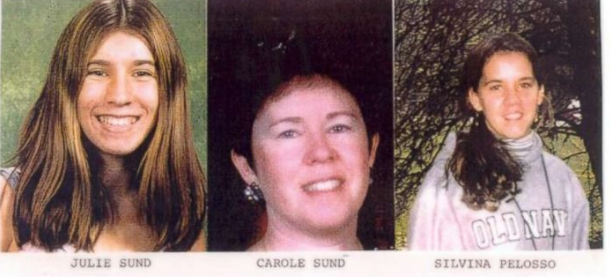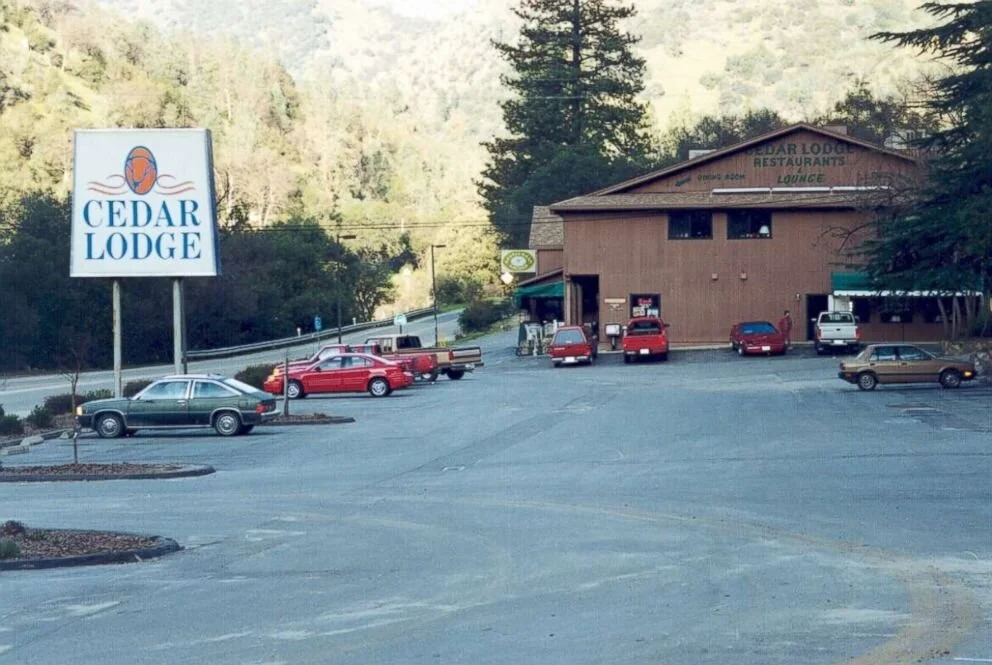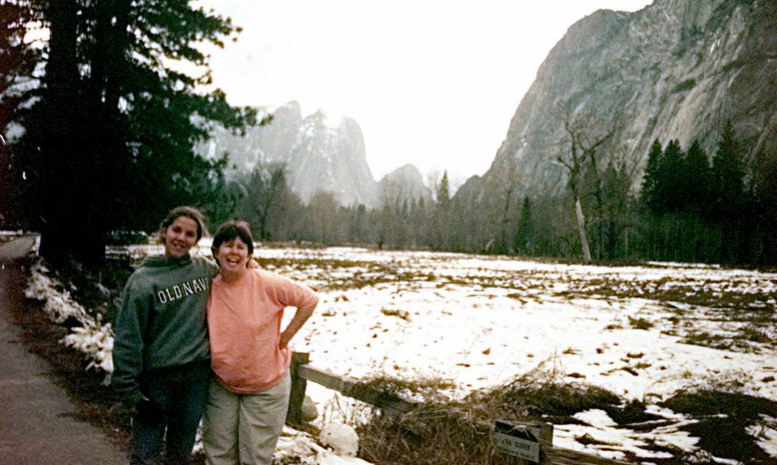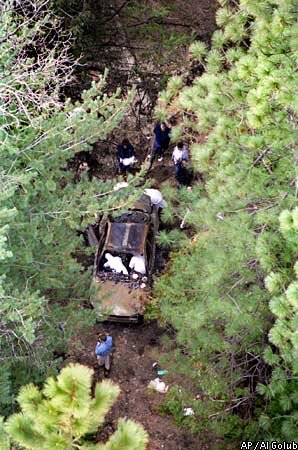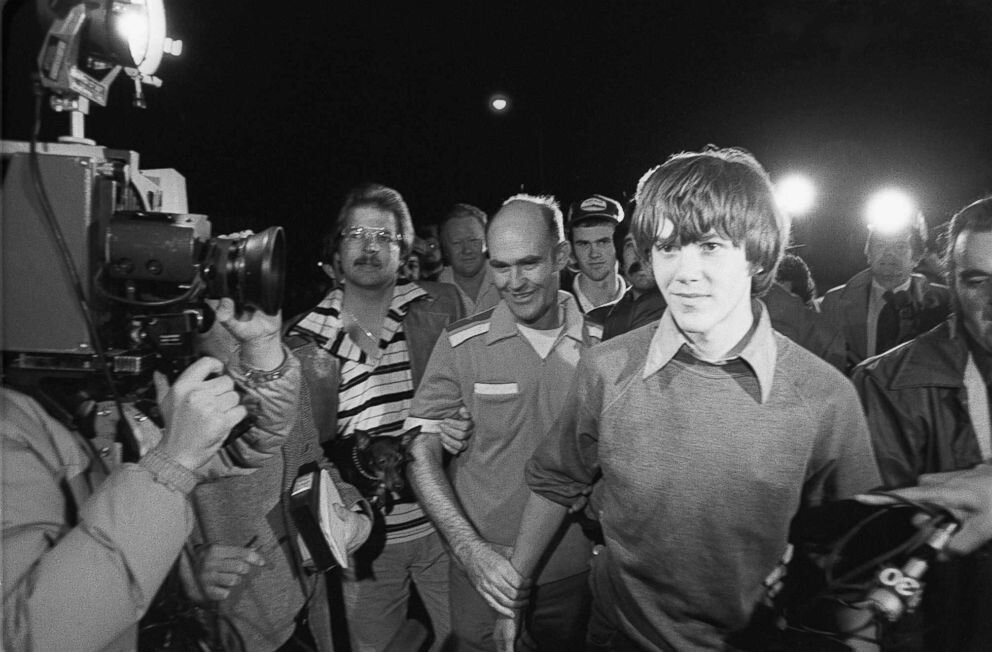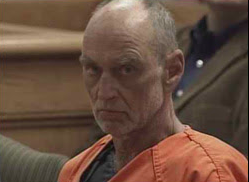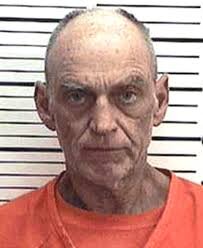
True Crime in the Great Outdoors
The most shocking crimes from national parks, camping trips, backpacker murders, and hiking incidents
The Yosemite National Park Sightseer Murders and the two faces of evil
Carole Sund, Juli Sund, Silvina Pelosso Killed February 1999, Joie Ruth Armstrong killed July 1999.
Revised November 2024
Background to the Yosemite National Park Sightseer murders - The Sund and Pelosso Murders
On February 12, 1999, Carole Sund, 42, her daughter Juli, 15, and Silvina Pelosso, 16, left their home in Eureka, California, to go on vacation in the area near Yosemite National Park in California.
After first flying to San Francisco, where Carole rented a red 1999 Pontiac Gran Prix, they stopped in Stockton, where Juli took part in a cheerleading contest at the University of the Pacific. On February 14, they headed for Cedar Lodge in El Portal, located on Yosemite's western slope. There, they got a room and planned to stay for a few days.
Carole and her husband, Jens, 43, owned a realtor business in the Stockton area. They had been hosting Silvina, a foreign exchange student from Argentina and Juli's friend. She was spending three months with the family. Jens couldn't accompany them on this trip because he needed to prepare for an upcoming business trip.
On February 15, the ladies hiked one of the many trails in Yosemite National Park. That evening, they grabbed some videos from the lodge's service desk to watch in their room. It was the last time the women were seen alive.
What followed turned out to be one of the most shocking crimes in both National Park and American history, involving a man whose family had already been involved in a notorious crime, literally the two faces of evil.
Cedar Lodge, 9966 CA-140, El Portal, CA 95318,
The inn staff claimed that when they cleaned the room the following day, they had detected no evidence of foul play or anything that made them suspicious. Check-out had been done in advance, and the keys were left on the room desk. Jens had scheduled to meet them at the San Francisco airport that evening on his way to Arizona, where the others would accompany him. While he attended his meeting, the women were to tour the Grand Canyon.
But he was surprised that he did not find his wife at the airport and assumed she had flown ahead. The next day, he tried to contact them again and failed, and he called the police. The hire car company confirmed that Carole had never returned the rented Pontiac nor told them they were extending their agreement.
The search for the Pontiac, the Sunds and Silvina Pelosso
Local police and Yosemite Park Rangers began to search the area where the missing three were last seen. The initial suspicion was that they may have wandered off the main hiking paths and got lost in the park.
For four weeks, police, family, and volunteers searched the area in and near Yosemite National Park by helicopter, foot, and skis. They were looking for the missing red 1999 Pontiac Grand Prix and the women.
Then Carole's wallet, which included money and credit cards, turned up in Modesto. Something was very, very wrong.
FBI agent Nick Rossi said on February 26, "At this point, we have not yet uncovered evidence to allow us to determine conclusively whether this was a tragic accident or a criminal act.” Two weeks later, FBI agent James Maddock, now placed in charge of the investigation, told the press, "We feel almost certain that the women were victims of a violent crime."
Carole and Julie Sund
Because of the discovery of Sund's wallet in suburban Modesto, police and FBI searched "the logical routes in and out of that spot, interviewing homeowners and business owners and others who may have seen them." The Bureau relocated its headquarters from Yosemite to Modesto at this point and, on February 28, twelve days after the women's disappearance, hinted that it is no longer treating the Sund incident as a missing person case but as murder. More than a thousand leads, they confessed, produced nothing. Still, the Bureau intensified its search, recruiting more high-tech equipment and air support.
Unofficially, Jens Sund offered a $250,000 reward for information that would lead to the return of the missing women. After a couple of weeks, he upped the sum to $300,000. But to no avail. Carole’s parents, Francis and Carole Carrington, appeared on the “Good Morning, America” TV show to ask for Americans' prayers and help locating their daughter and the children.
The other Sund children believed their mother and sister Juli would be returned. But by the middle of March, their hopes faded. "Her mother, sisters, and a family friend had been missing for a month by the time Gina Sund read her poem in front of a thousand or so people who gathered in Modesto," writes Time. "'Deep in my heart, I know something my mind does not want to learn,' said Gina,13. 'I try to stay strong because I know that's what you'd want your baby to be, but, Mommy, I don't want you to leave me.'"
Yosemite murders Sund pontiac burnt out
Discovery of the bodies in the Stanislaus Forest and Lake Pedro
The Sund family's worst fears were confirmed when a hiker wandered onto the site of a burned-out red 1999 Pontiac, hidden off Highway 108, in the Stanislaus Forest region on March 18. The California Highway Patrol verified the car's license plate as the Sund’s rented vehicle and immediately notified the FBI. Agents arrived at the scene early on the 19th, and upon opening the trunk, investigators found two charred bodies.
After several days, dental records identified the bodies as Carole Sund and Silvina Pelosso.
Then, on March 25, Juli Sund’s body was discovered near Lake Pedro in Tuolumne County. It was severely decomposed, and her throat had been cut.
FBI arrests
Over the next few weeks, a task force, including FBI agents and law enforcers from four surrounding counties, arrested several known sex offenders, drug users, and ex-convicts with a record of violence from within a 75-square-mile area between Modesto and Sonoma. The police reckoned that the killer of the three women was someone familiar with the county, given the location of the Pontiac. The car was hidden off a spur road where locals dump old refrigerators, cars, and washing machines.
By mid-April, those arrested were ordered to testify before a grand jury in Fresno, California.
Four men were considered the main murder suspects in the initial inquiries. By the end of June, the FBI had reviewed the testimonies and the evidence linked to the suspects in custody. At that time, the Bureau stated that, while no one had yet been charged, it felt that those responsible for killing the three women at Yosemite were already behind bars.
Michael "Mick" Larwick, 42, of Modesto, was part of a vagabond group of methamphetamine drug users and friends centered in the Modesto area. Larwick, who grew up in Tuolumne County near where the bodies of Carole Sund and Silvina Pelosso were found, was jailed on March 16 after he allegedly shot a Modesto police officer. He had a long criminal record and had been questioned extensively by the FBI. He denied any role in the Yosemite slayings.
Eugene "Rufus" Dykes, 32, also of Modesto and Larwick's half-brother, was arrested in March.
Billy Joe Strange, 39, an El Portal parolee who worked at the Cedar Lodge lounge and restaurant where the murdered women were last seen. He was arrested on March 5 when he allegedly reported to his parole officer with liquor on his breath. The FBI pushed for Strange's arrest, but he denied any part in the triple murders.
Darrell Gray Stephens, 55, Strange's roommate. Convicted in 1978 for rape and robbery, he was jailed on March 14 for failing to register as a sex offender.
Other suspects were:
In April, Rachel Lou Campbell, 36, of Modesto, was charged with stealing checks and credit cards and converting them into cash and merchandise worth $365,000. When first arrested on mail fraud charges, Campbell had in her possession Carole Sund's checking account and automated teller machine numbers.
Larry Duane Utley, 41, an associate of Dykes and Larwick, first picked up during a March parole sweep. He was arrested on an unrelated crime charge in May but was soon released.
Teresa Kay Gray, 36, of Modesto. The FBI task force investigating Yosemite issued a federal warrant for her arrest after she failed to appear in Stanislaus County drug court in June.
Kenneth"Soldier" Stewart, 24, a former cellmate of Dykes was charged with attempted murder. He has been questioned about any involvement.
Angelia Dale, who testified before the federal grand jury. She was subpoenaed because she is a friend of Dykes and Larwick.
Maria Ledbetter, 24, of Modesto, an admitted methamphetamine addict and former girlfriend of Dykes, about whom she was questioned extensively.
Jeffrey Wayne Keeney, 32, of Modesto, was arrested on an unrelated drug charge and questioned about the Yosemite case.
One of those arrested and later released was Cary Stayner, who worked at the Cedar Lodge as the handyman. He had no criminal record, and his only encounter with the law was for marijuana use in 1997.
The Joie Ruth Armstrong Murder
Joie Ruth Armstrong
Then there was another murder. Acting on a tip from a caller who was worried about the whereabouts of his friend, Joie Ruth Armstrong, 26, park rangers found her decapitated body on the morning of July 22, 1999. It was discovered beyond a campground adjacent to her living quarters in the Foresta community, a group of 30 cabins for use by park workers. Her body was next to a stream, and her head was within the water that she and her friends used for drinking water.
She had been working for the Yosemite Institute for the past year and had worked on education programs through a partnership with the National Park Service.
She had probably been murdered on the evening of Wednesday, July 21. She was seen at the Institute offices that day and was planning to visit a friend in Sausalito, California, but never made it. When she did not appear as scheduled, her would-be host had phoned the park. Police found her car in front of her cabin, packed for the trip.
Chief James Maddock said he questioned whether the Bureau could have done anything to prevent Armstrong's killing. "I've struggled with that issue for the last 24 hours and continue to do so," he confessed. He did feel, however, that the FBI spared nothing to investigate the earlier killings. "I'm confident we've done everything that could be reasonably done."
On Saturday, July 24, FBI agents announced at a press conference that a man was in custody on strong suspicion of murder and that a "significant announcement" would be made shortly.
The arrest of Cary Stayner
Cary Stayner
The suspect, Cary Stayner, 37, had been one of the people questioned after the triple killings in February, but, at that time, no evidence linked him directly to the crime, and he had been released. Because he was the handyman at the Cedar Lodge in El Portal, where the Sund & Pelosso group had stayed before they were murdered, his questioning at that time seems to have been more routine than anything.
This time, agents detained him and forced him to answer more questions. Investigators searched his truck and confiscated his backpack for examination. Upon release, the FBI warned him not to leave El Portal.
According to the San Francisco Chronicle, "(A witness claimed that) Stayner was angry about authorities seizing his backpack after he was questioned earlier that day. He was also angry about how his truck had been searched."
Stayner's apartment was searched later in the day, and the authorities discovered evidence that linked him to Armstrong's murder. Special agent Maddock said, "During the last 24 hours, we have developed specific information linking Stayner (also) to the Sund-Pelosso murders."
In the meantime, by Friday, July 23rd, Stayner had disappeared from the area by the time agents came to arrest him. They finally found him at the Laguna Del Sol nudist colony, which he frequently visited. Its manager had seen a story on television, recognized Stayner's photo as one of his guests, and notified the FBI. Agents descended on the colony and returned him to El Portal on Saturday, where he was interrogated more.
On the way to his police interview, he confessed to a detective in the car to murdering Joie Armstrong, describing the brutal killing "as if he was reading a soup label," said John Boles, another FBI agent on the case. Soon after, he confessed to murdering Carole Sund, Juli Sund, and Silvina Pelosso once in custody.
Stayner told investigators, “I want you to get a hold of some producers in Los Angeles. I want a movie-of-the-week made about my story,'" There was a movie made about his brother, Steven Stayner, and he wanted the same and for the world to take notice.
By the end of that evening, the FBI felt it had gathered enough evidence to arrest Cary Stayner for murder. On Sunday morning, they rushed him to Fresno to officially lodge a complaint, then to Sacramento on Monday, where he was put before the courts.
That same day, Stayner allowed himself to be interviewed by a reporter from KNTV. During the session, an unexpected event occurred. In a voice that seemed relieved to be unburdened from its depth, a long-kept secret, Stayner yelled, "I am guilty. I did murder Carole Sund, Juli Sund, Silvina Pelosso and Joie Armstrong ...None of the women were sexually abused in any way."
In (the) interview, Stayner said he had fantasized about killing women for the last 30 years and described in detail how he murdered all the women. He had strangled Pelosso and Carole Sund in their rented cabin in the Cedar Lodge motel, then took Juli Sund to a lake, where he killed her early the following day.
He abandoned the group's rental car with the bodies of Carole and Silvina inside, returning two days later to burn the evidence and retrieve the wallet, which he dumped in Modesto to confuse authorities. Stayner said he thought he had gotten away with the earlier crimes but could not resist the urge to kill Armstrong after he struck up a chance conversation with her.
Concluding the interview, he addressed the victims' families: "I am sorry their loved ones were where they were when they were. I wish I could have controlled myself and not done what I did."
FBI sources claimed that he had already confessed his guilt during the Saturday evening interrogation. In the Bureau's mind, this time, it had the right man. He had given the FBI details "only the killer would know in such specificity that agents were able to recover evidence confirming his confession. Knives were used in the slayings, and the weapon suspected in Ms. Armstrong's death was recovered."
The critical evidence against Cary Stayner
According to Special Agent Christopher Hopkins, both the FBI's Evidence Response Team and the Mariposa County Sheriff's Office collected items of potential interest from Room 509 at the Cedar Lodge Motel, the room in which Stayner sexually assaulted Juli Sund and Silvina Pelosso and murdered both Carole Sund and Silvina.
In his interview, Stayner claimed that hair from his body was left on the bedspread in their motel room, but he returned later and changed the bed. Upon examination by the FBI Laboratory, some items have yielded trace evidence. Among other things, the FBI Laboratory has found hairs in vacuum sweepings taken from Room 509 and possibly body fluid stains on a blanket (and) a latent palm print from the window sill.
Vacuum sweepings were taken from inside Joie’s house, where Stayner claims to have bound her with duct tape, yielding hair evidence. The FBI Laboratory has also found possible bodily fluid stains on a bed sheet taken from her residence. The FBI also seized clothing stained with blood from her body. Although most of the stains were likely to include Armstrong's blood, Stayner was observed to have a laceration on his hand during his interrogation and, therefore, may have been cut and bled during the attack. Latent fingerprints were also lifted from the interior of Joie Armstrong's truck, which Stayner admits to touching during his encounter with her.
Who was Cary Stayner?
A relatively quiet but friendly motel handyman called Cary Stayner’s only passions seemed to be nude sunbathing and hiking. On days off, he would escape to Laguna Del Sol, a nudist colony in Sacramento County. Despite this, he never appeared to behave lewdly or perversely in public. Or, indeed, nothing noticed by his colleagues at the motel. However, there were warning signs during his younger years.
Stayner's father, Delbert, admitted that he thinks his son Cary may have suffered a trauma at age 11, when younger brother Steven, then seven, was abducted in 1972, disappearing for eight years. At that time, Steven had been forced to endure sexual abuse by his kidnapper, whom he finally turned in to the police. But, says Delbert, puberty-aged Cary endured some emotional hardships because of that incident.
After graduating from Merced (California) High School, Stayner worked as a window installer at a glass company. In 1997, the Cedar Lodge hired him as a handyman and gave him a small apartment on the top floor. Management found him to be a hard worker and honest. In his capacity, Stayner performed technical and housekeeping duties, everything from fixing electrical and mechanical breakdowns to delivering extra towels and bedding to guests. He usually ate lunch and dinner at the motel restaurant.
Some who knew Cary were shocked at his arrest. Sandy Cox, whose husband owned the window company where Stayner worked in Atwater, says, "We've known Cary since he was a little boy...It just doesn't match up. Out of respect for his family and the victim's family, we don't want to say anymore." Silvina Pelosso’s mother, Raquel, said, ” I just cannot understand how so many people...didn't realize that maybe (Stayner) was the man since I heard that he was interviewed some time ago."
The FBI was reluctant to finger Stayner because they, and many others, did not believe that Stayner acted by himself, given the brazen killing of the three women in the Cedar Lodge Motel and the disposal of the bodies. Many residents were convinced that no one person could have created so much horror, "' The logistics of it say it had to involve more than one person, said Letty Carolyn Barry, owner of the Yosemite Rosebud Lodge, west of Cedar Lodge. "Privately, some members of the Sund-Pelosso task force were saying the same things to the media. Those sources say it is difficult for some investigators to believe Stayner could have gotten the jump on all three women without any help, let alone dispose of their bodies."
Prosecution for the Yosemite Sightseer Murders
The trial of Cary Stayner was moved from Mariposa County to Santa Clara County, CA. In May 2002, Stayner pleaded not guilty by reason of insanity in the 1999 murder of Pelosso and the Sunds.
The trial began in Judge Thomas C. Hastings’ courtroom in mid-July 2002. George Williamson headed the prosecution team, and Marcia Morrissey led the defense team.
On Monday, July 22, the court heard Stayner’s taped confession, which he had given to FBI agents. In this, he calmly reviewed how he strangled 16-year-old Silvina Pelosso in the motel bathtub and how he sexually assaulted Juli Sund for hours before brutally cutting her throat.
He had talked his way into the room under the guise of fixing a leak and then sexually assaulted both girls and brutally murdered Carole Lund and Silvina Pelosso in the room. He then carried Juli to a vista point near Lake Don Pedro, pledged his love, and then cut her throat as the sun rose.
The issue was no longer who committed the murders but whether Stayner was insane at the time and whether the confession to the FBI agents was coerced.
Stayner, clad in a red jail jumpsuit, bowed his head but showed no emotion as Judge Hastings sentenced him to death three times, once for each murder, after returning to the courtroom.
Stayner was already serving a life sentence for the murder of Joie Ruth Armstrong. The issue of whether his confession was coerced seemed to be resolved when, on July 24, the court heard the recorded demands that Stayner made to the FBI agents that he wanted to be satisfied before he would give them his confession.
He demanded that his parents be given the reward money, that he be incarcerated at a prison near his parents’ home, and, to Stayner’s detriment, that he be given a large cache of child pornography. Previously, the defense had maintained that the FBI had coerced the confession. In the end, Stayner confessed without the promise of child pornography or reward money for his parents.
Hastings rejected new defense claims that juror misconduct prevented a fair trial. The judge said there was overwhelming evidence against Stayner and that the devastating emotional toll justified execution.
”I’ve never seen anything that’s so close to black and white and evil and good as Stayner and our children,” said Francis Carrington, the father of Carole Sund and grandfather of Juli. ”I’m so proud of the way Carole and Juli lived, and I’m so ashamed of Stayner.”
Stayner’s father, Delbert Stayner, said his son was deprived of a fair trial by a ”kangaroo court” and a judge who ignored defense arguments. ”All of it’s been bad,” Delbert Stayner said of his family’s life.
”I’m just horrified when I think of what happened in that room, what my daughter felt when she realized she was in serious trouble,” said Carole Carrington as she asked the judge to sentence Stayner to death. ”How frightened the girls must have been when he cut their clothes off.”
Stayner slayings - other near misses
A woman named Lenna learned in 1999 that Cary Stayner had nearly murdered her mother, her sister and her. Her mother had been dating him, and he had decided to kill them on Valentine’s Day. His attempt was foiled when other people were at the house when he was planning to commit the crimes.
The Stayner Family - The Two Faces of Evil
The two brothers of the Stayner family are both famous - one experienced horror at the hands of a child molester, Steven, and the other, Cary, the serial killer in Yosemite. How can one family contain two completely contrasting children?
One brother was subjected to unspeakable horror for years, but by all appearances, he was a happy-go-lucky, cheerful kid with a girlfriend. You have the other brother who's left at home. He had no interest in girls or people; he was just a creepy loner.
The Stayner family consisted of two brothers, three sisters, and parents Kay and Delbert. They lived in the farming town of Merced, California, the “Gateway to Yosemite.”
Steven Stayner helped another child escape from a pedophile, after enduring years of abuse and not wanting to see the child experience the same fate.
Cary looked out for Steven, according to Cary Stayner's former classmate Jack Bungart. “He loved his brother. You know, hung out with him, played with him.”
The boys were still in elementary school when, on December 4, 1972, a man named Kenneth Parnell took seven-year-old Stephen while walking home from school on Highway 140.
On December 4, 1972, at age seven, Steven was approached after school by Edward Ervin Murphy, who claimed he was collecting money for the church. After Steven said his mother would be interested in donating, Murphy offered to take the boy home.
It was then that Steven's nightmare began as Murphy brought him to Kenneth Parnell, a known pedophile. Parnell, along with Murphy, took Steven to a cabin in Catheys Valley, where he was brainwashed to believe his parents no longer wanted him.
Parnell worked at the Yosemite Lodge, about two hours from the Stayner home. He befriended a co-worker named Ervin Murphy to assist him in the abduction. Parnell and Murphy were driving towards town when Stephen was lured into their vehicle and abducted.
Timothy Lee White, 5, gets a piggyback ride from 14-year-old Steven Stayner at a news conference in Ukiah, California, in 1980
Kenneth Parnell stops the car and goes to a payphone. When he returns, he tells Steven, “Your parents, I just spoke to them. They no longer want you.”
When Steven didn’t return from school that afternoon, his parents sounded the alarm. An extensive search turned up nothing.
Cary was 11 years old at the time and deeply upset about his brother's disappearance. "I remember going out one night after Steve disappeared and wishing on a star that my brother would come back home," Cary reportedly told Mike Echols, author of the book I Know My First Name Is Steven. "And I did that almost every clear night from then on until Steve finally came back home. I never did tell anybody about it, but I remember wishing on a star that my little brother would come back home."
Steven Stayner with his kidnapper Kenneth Parnell
For years, Parnell traveled around California with Steven. Steven Stayner had a new father figure, and it was Kenneth Parnell, who, by day, was his father, and by night, was his rapist. Steven was told his new name was Dennis Parnell, and was enrolled in school. Against the odds, he flourished there.
"He had a great personality," said Lori Duke, who dated Steven in high school but knew him as Dennis. "He was spunky. You could see that he wanted to play and be with kids and be normal."
Steven Stayner and Cary Stayner in the baseball cap in the background
While Steven was a freshman at Mendocino High School, some 300 miles to the south, his older brother Cary was an upperclassman at Merced High School.
Cary always wore a hat because he was compulsively pulling his hair out. Emotionally, Cary Stayner had a tough time during his childhood. He also exhibited some behaviors that made others uncomfortable, including, as he later admitted, exposing himself to his sister's friend.
It seemed as though he had a compulsion to try to get close to women or be sexual with them. Still, he was unable to develop any interpersonal relationships with any women.
By the time Steven was 14, he had been abused and manipulated by Parnell for seven years, and Parnell and Steven together realized that Steven was growing up and that he was no longer going to be controlled by Parnell. They would need to find someone else that they could sexually abuse.
In February 1980, Parnell decided to kidnap a new victim. He paid a local kid to ride with him to the town of Ukiah, California, and he told him to go and find him a boy. 5-year-old Timothy White was walking home from school, and they quickly snatched him.
For two weeks, Steven watched Timothy suffer the separation from his family. Then he took action. On March 1, 1980, Steven waited until Parnell was at work and fled the house with Timothy. The two hitchhiked to Ukiah, California. It was dark when they arrived, and Timmy couldn't remember where he lived, so they went to the police station.
Steven told the police what had happened to him and Timothy, and he could also tell them that his real name was Steven, not Dennis.
Steven was a national hero. On Good Morning America in March 1980, Steven shared with host David Hartman that it felt "great" to be home. He told Hartman that his parents "didn’t change that much," but his brother and sisters "they changed a lot. I never recognized either one of them."
Everyone was smiling at a press conference outside the Stayner house, but Cary, in his baseball cap, wasn’t smiling at all. The brothers, four years apart in age, shared a room but didn’t get along. Steven didn't understand the rules he was now expected to follow. He also struggled in high school, where he was bullied for the abuse he had endured.
Parnell was convicted on kidnapping and false imprisonment charges. He was sentenced to seven years in prison but only served five, less time than he held Steven captive. Ken Parnell went back to what he had been doing for years.
He was charged with attempting to purchase a child and attempted child molestation in 2004, and he was sentenced to 25 years to life. He died in jail in 2008 at the age of 76.
He was known to take refuge in nearby Yosemite, where he’d drive up and get lost in nature. He walked naked and smoked pot, and he could find the peace that he so desperately needed.
Steven Stayner’s fame was short-lived. He grew up, got married and had two kids. Tragically, Steven Stayner was killed in a 1989 motorcycle accident at the age of 24. Shortly after Steven’s death, an uncle with whom Cary Stayner was very close was shot and killed in a home they shared. By this point, Cary Stayner had a couple of nervous breakdowns.
"He stated that he felt like jumping in a truck, driving it through the shop and killing the boss and killing everybody in the office, and then torching the place," friend Mark Marchese said in 1999. "That’s when I told him, 'You need to go to a doctor, Cary.'" But instead of seeking mental health treatment, he moved to Yosemite.
In 1997, Stayner got a job as a handyman at the Cedar Lodge, seven miles from the national park's gate, where he worked for two years before the murders.
"It’s difficult for me to picture what Cary has done and knowing Steve because their personalities are completely opposite," Duke, Steven’s former girlfriend, said. "The only time Steve would kill anything like a fish is because we were gonna eat it. You know what I mean? ... I wouldn’t think that he would think of himself as one, but he is a hero."
"We never really got along that well after he came back ... All of a sudden Steve was getting all these gifts, getting all this clothing, getting all this attention. I guess I was jealous. I'm sure I was... I was the oldest and all that. Then all of a sudden it's gone. I got put on the back burner, you might say," Cary told J.P. Miller, a filmmaker who wrote a screenplay about Steven's abduction.
Timothy White dies at 35
Timothy White, the kidnap victim, was only 35 when he died. The dramatic story was told in the 1989 television movie, “I Know My First Name Is Steven.”
White’s stepfather, Roger Gitlin, said White died on April 1, 2010, of an apparent pulmonary embolism. He was buried Thursday in Newhall, where he had worked as a Los Angeles County sheriff’s deputy.
Exclusive articles for members of StrangeOutdoors that are not available elsewhere on the site.
See the latest list of Exclusive members-only articles on StrangeOutdoors.com
See more StrangeOutdoors True Crime Stories
Further reading and listening
https://casefilepodcast.com/case-161-the-yosemite-sightseer-murders-part-1/
Sources
https://murderpedia.org/male.S/s/stayner-cary.htm
https://en.wikipedia.org/wiki/Cary_Stayner
https://abcnews.go.com/US/steven-cary-stayner-tale-brothers-horror-heroism/story?id=60529944
https://www.latimes.com/local/obituaries/me-timothy-white10-2010apr10-story.html
https://www.goodhousekeeping.com/life/a26040174/cary-stayner-steven-yosemite-murders/
https://abcnews.go.com/US/video/july-25-1999-cary-stayner-arrested-murder-yosemite-60263995
https://abcnews.go.com/US/woman-recalls-moment-family-learned-target-1999-yosemite/story?id=60364987
https://www.theunion.com/news/local-news/stayner-sentenced-to-death/


